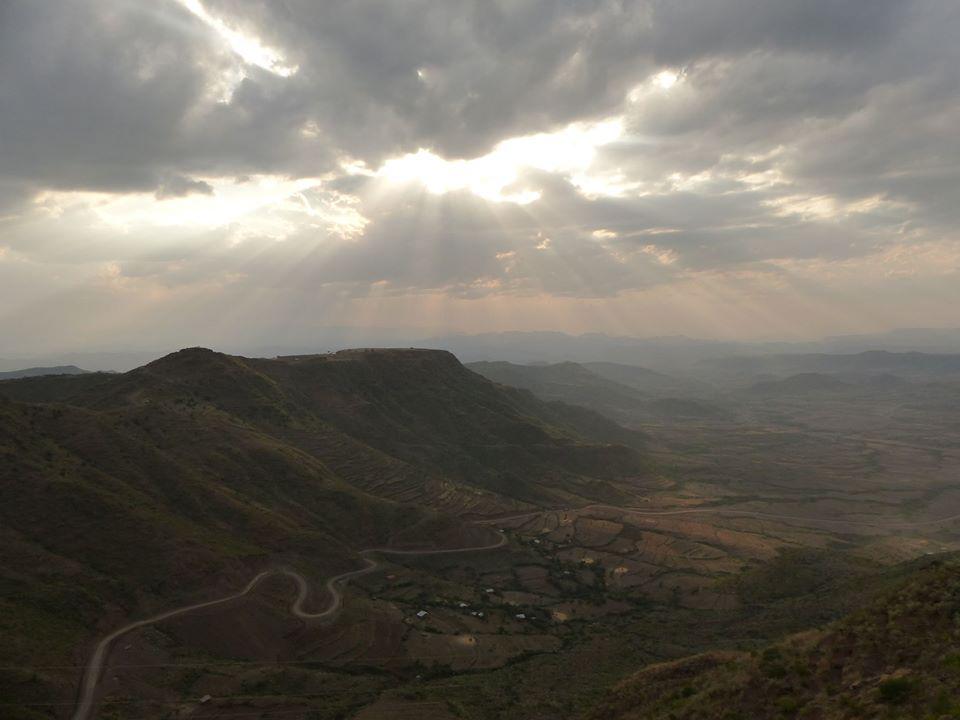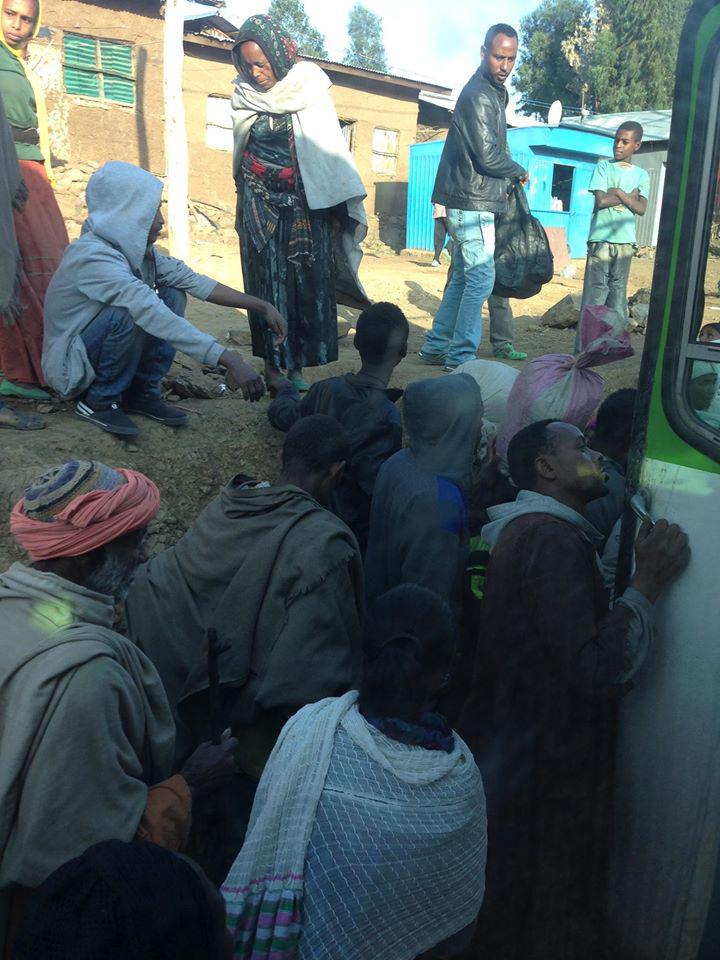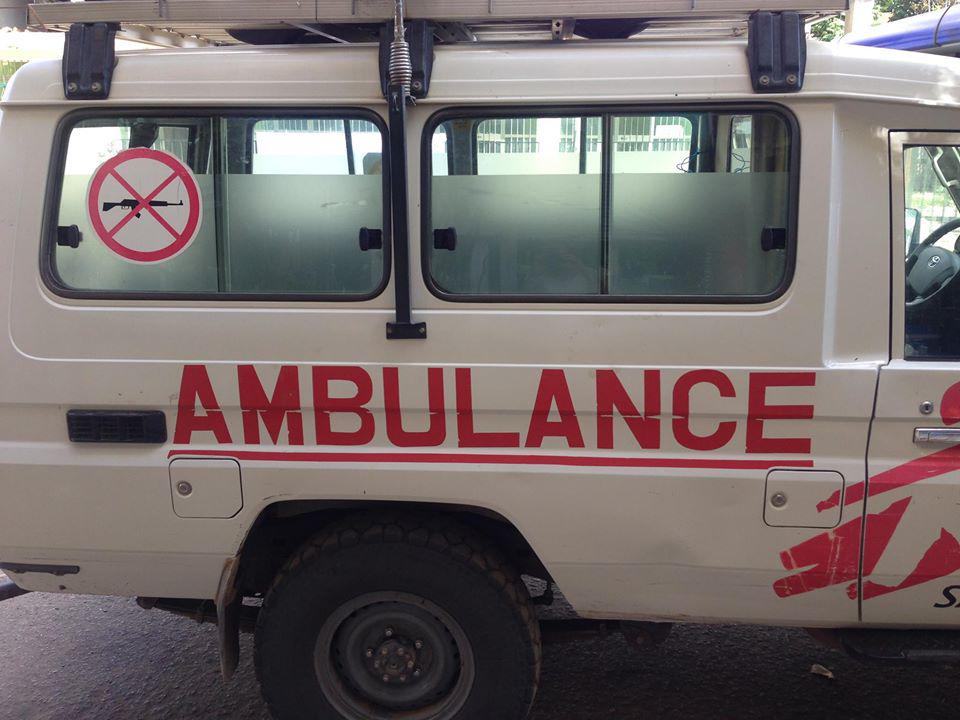Don’t like your public transport?
…Then don’t try it here.
Ethiopia is a big country. The north in particular, is rugged and mountainous. The roads are poor, and distances between towns are long. That’s why most visitors to Ethiopia fly between places like Lalibela and Bahir Dar. But not us. We try to stay on the ground wherever possible. If you could see our methods of travel – for example, this rattletrap bus I’m sitting on where three seats are crammed into the space for just two, and I’m attempting to type on my iPad as we crash into an endless series of potholes – you’d honestly think we woke up in the morning and said to each other:
Sar: “What do you suppose is the single most agonizing way we could get from point A to point B today?”
Oyv: “I’m glad you brought that up. I was thinking we should take the bus.”
Sar: “Great idea. I heard it’s a 6 hour journey so that means it should take at least 10 hours. But the driver will make time by driving like a lunatic on any stretch of paved road.”
Oyv: “Definitely. The road is mostly a disaster and the suspension will be totally shot. We’re in for a long bumpy ride!”
Sar: “That’s fine. I’ll be gripping the seat back ahead of me and bracing for impact most of the trip anyway.”
Oyv: “And chances are high the other passengers will throw up in the aisle on the bends in the road.”
Sar: “Sure thing, but we’ll pass plastic bags around, no big deal.”
Actually we’ve just pulled over to clean up the aisle. The driver’s friends sprinkled dirt and leaves over the mess.
I was happy; I got to straighten out my limbs for a bit. We’re both too long-leggy for these seats.

But I wondered if some of this sudden flurry of activity was a ruse to distract us from the fact that the driver himself was currently crawling around under the front of the bus with a wrench.
Our oddessys always begin with a visit to the local bus station where we are mobbed by touts, much like a scene from The Walking Dead (I really miss watching that show). Touts are after a commission on us, and we have to ignore them all and find the ticket office. Even so, it usually takes around 8 guys to sell us two tickets or organise any single aspect of a bus trip.
Next, we need to determine when the bus will actually hit the road. Ethiopia runs on a different system of time. I’m not referring to ‘Africa Time’ – the colloquial concept that things start when they start – that’s just a given. No, I mean that Ethiopia actually measures time on a different clock. Our 24 hour day is divided into two 12 hour cycles, starting at what we would call 6 am and again at our 6 pm. Basically you need to count 6 hours ahead of or back from any given time. So if a local says the bus leaves at 10:30 he means 4:30 am – unless of course, he has converted to ‘western’ time for us, and actually means 10:30 am, or he’s got his English numbers mixed up and means 11:30 on the Ethiopian clock (so….5:30 am). Or maybe he meant 11:30 our time. The best bet is to just get up really early, earlier than any number he may have mentioned, and go to the bus station.
I should also say that Ethiopia follows the Julian calendar rather than the Gregorian one used in most of the world. So it’s only 2008 here and we’re all 8 years younger. That alone is reason to visit if you ask me.
Before we depart, let me set the stage for our dramatic and scenic journey: winding cliff-edge roads and freely roaming livestock. Bus travel in Ethiopia is not for the faint hearted.

Then a tout hurls our backpacks onto the roof of the bus, demands a tip for this service, and we’re off! The adventure continues onboard, mainly via the driver’s usual antics. In every town, he slows to a crawl and attempts to coerce any passing villager to join us. Generally the rest of the villagers then try to fight their way onboard.

When the driver realizes he’s gone too far and the bus is overcrowded with people who don’t appear to have had any intention of travelling cross-country in the first place, arguments erupt and he starts slamming the doors in the face of would-be passengers.
On one memorable occasion, our driver leapt from his seat (kudos to him for stopping the bus first) and forcibly evicted an unwanted passenger by the scruff of the neck.
Another time, I saw man try to board with a live goat around his shoulders.
I think it’s possible the Ministry of Transport may be running an awareness campaign called ‘Faranji Hate and Fear Our Driving Skills’ because on two separate occasions now I’ve had a bus driver take me aside and courteously enquire how I find his driving to be. And in that case the campaign is working because both of us have been favorably impressed so far; the drivers do generally take it pretty easy and they know the roads.
Just to slow our progress a little bit more, the police tend to pull the buses over from time to time. They either make the men get off and search them, or make us all get off and search our bags. I’m often exempted from this and just waved back to my seat. What they are looking for is anybody’s guess. It’s no secret that people carry guns here. We see them everywhere in the countryside, although not on the bus. Or in ambulances:

But really – there is no better way to experience a country than to see it roll by in slow motion or fast forward, depending on the state of the bus, the road, and the driver’s mental health. Remote villages flash by outside and inside a microcosm of daily life plays out around us. We stop for lunch, coffee and a much needed stretch in little market towns that the fly-by tourists will never see. Getting on a bus early in the morning, we wonder what the day will bring and what awaits us in the next town, and the one after that. And after all…getting there is half the fun.
At any rate, we made it to Addis Ababa.
Read More
For more of our adventures (and misadventures) in Ethiopia, check out the rest of my stories from the road.



